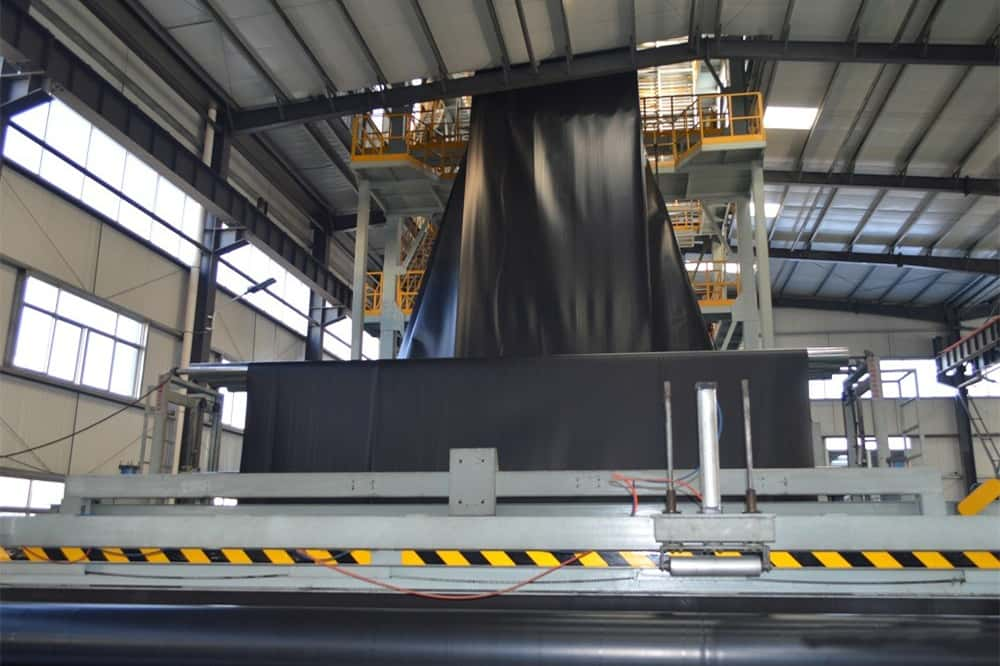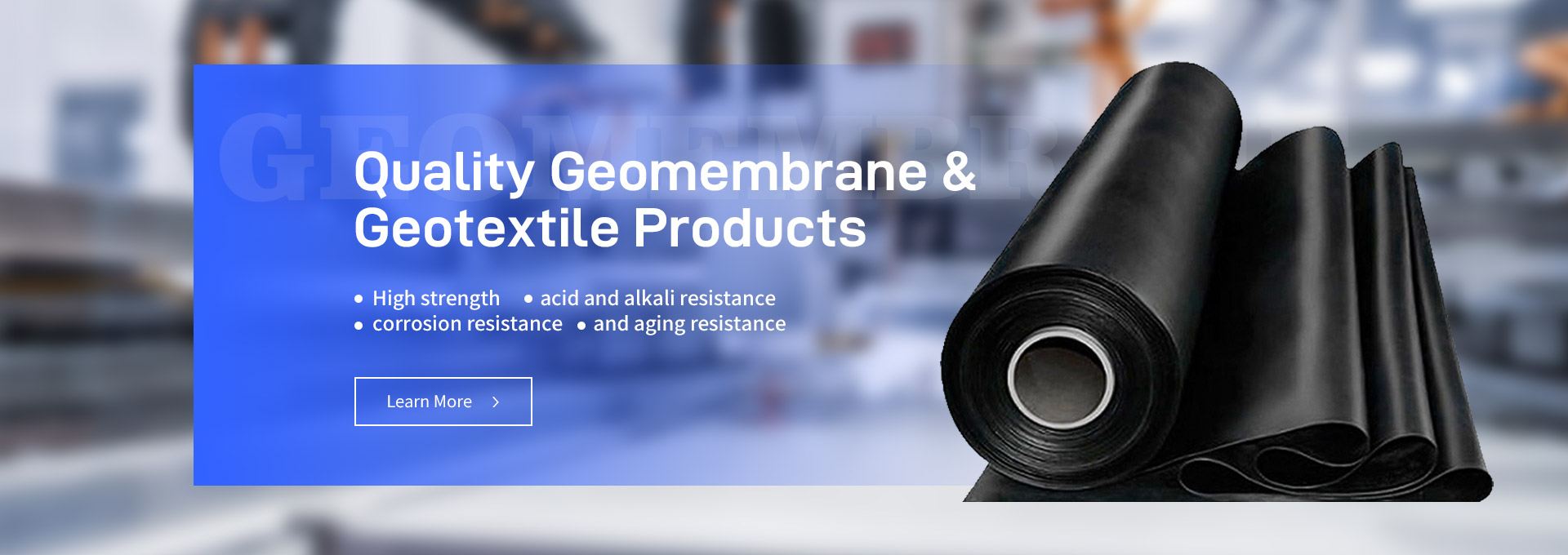Geomembranes, as functional materials, play a crucial role in anti-seepage engineering, environmental protection, agriculture, and water conservation. Their unique impermeability and durability make them indispensable in addressing soil and water pollution, flood prevention, and agricultural irrigation. This article will provide an in-depth look at the production process of geomembranes, detailing each stage from raw material selection to the final product, helping readers better understand the production technology and the importance of geomembranes in various applications.

1. Definition and Uses of Geomembranes
1.1 Definition of Geomembranes
Geomembranes are thin film materials primarily made from polymer resins such as high-density polyethylene (HDPE), low-density polyethylene (LDPE), or polyvinyl chloride (PVC). These membranes are engineered for exceptional impermeability, tensile strength, and chemical resistance. As a part of the geosynthetic materials family, geomembranes are typically used in combination with other geosynthetic products (such as geotextiles and geogrids) to enhance their engineering performance.
1.2 Main Uses of Geomembranes
Geomembranes are mainly used for seepage prevention and isolation. They are widely applied in the following fields:
Environmental Protection Projects: Used in landfills, chemical plants, and mining sites to prevent contaminants from seeping into the soil and groundwater.
Water Conservation Projects: Applied in reservoirs, artificial lakes, dams, and channels for impermeability purposes.
Agriculture: Used in aquaculture ponds, irrigation systems, ensuring efficient use of water resources.
Construction and Infrastructure: Utilized for waterproofing basements, tunnels, and subways.
2. Raw Materials for Geomembranes
2.1 Polymer Materials
The primary raw materials for producing geomembranes are polymer resins. Different types of geomembranes use varying polymer materials. The most common ones are:
High-Density Polyethylene (HDPE): HDPE is one of the most widely used materials for geomembranes, known for its excellent chemical resistance and durability, making it ideal for long-term applications in environmental protection and water conservation projects.
Low-Density Polyethylene (LDPE): LDPE offers superior flexibility and adaptability, making it suitable for applications where flexibility is a critical requirement.
Polyvinyl Chloride (PVC): PVC geomembranes have good chemical resistance and flexibility, making them suitable for specialized anti-seepage engineering, particularly in chemical environments.
2.2 Additives
In addition to polymer resins, various functional additives are incorporated during the production process to enhance the physical and chemical properties of the geomembrane. These additives include:
Antioxidants: Added to slow down the aging of the geomembrane in high-temperature or sun-exposed environments.
UV Stabilizers: Help improve the geomembrane's resistance to weathering when exposed to outdoor conditions.
Color Masterbatch: Used to impart color to the geomembrane, with black being a common choice due to its superior UV resistance.
3. Geomembrane Production Process
The production of geomembranes involves several key steps, including polymer extrusion, calendering, or blow molding, and each step plays a crucial role in determining the quality of the final product.
3.1 Raw Material Preparation
The first step in producing geomembranes is preparing the raw materials. The polymer resins (HDPE, LDPE, or PVC) are typically stored in pellet form. Before production, these pellets undergo screening and cleaning to ensure purity. The additives (such as antioxidants, UV stabilizers, and color masterbatches) are then mixed with the polymer resins in specific proportions to ensure the desired physical and chemical properties in the finished geomembrane.
3.2 Polymer Extrusion
The mixed materials are fed into an extruder, where the polymer pellets are heated to a molten state, typically between 200-250°C. The extruder uses a screw mechanism to push the molten material toward the die head, where it is shaped into a continuous thin film through pressure and orientation.
3.3 Calendering or Blow Molding
After extrusion, the geomembrane can be formed using either the calendering or blow molding process.
Calendering: In calendering, the molten polymer is passed through a series of rollers, where it is stretched and cooled to the desired thickness. This process is ideal for producing large, flat sheets of geomembranes.
Blow Molding: In blow molding, the molten polymer is blown into a tube by introducing air, which inflates the material. The tube is then cooled and flattened. This method is typically used for producing geomembranes with higher tensile strength due to the biaxial orientation achieved during the blowing process.
3.4 Cooling and Shaping
Once formed, the geomembrane needs to be quickly cooled to prevent deformation at high temperatures. Cooling rollers or water are commonly used to lower the temperature of the geomembrane. After cooling, the geomembrane is cut to the required width and length and rolled for easy storage and transportation.
3.5 Quality Control
Quality control is essential during the production of geomembranes. The primary quality checks include:
Thickness Measurement: Ensuring the geomembrane has a uniform thickness that meets the design specifications.
Tensile Strength Testing: Evaluating the geomembrane's tensile strength to ensure durability in use.
Permeability Testing: Verifying the geomembrane's impermeability, especially important for environmental protection and water conservation projects.
If any issues are detected during quality control, adjustments are made to the production process to ensure the geomembrane meets all required technical standards.
4. Advantages of Geomembranes
4.1 Superior Impermeability
The most notable feature of geomembranes is their exceptional impermeability. Whether used in landfills or reservoirs, geomembranes effectively prevent liquid seepage and stop contaminants from spreading into the environment.
4.2 Chemical Resistance
Geomembranes exhibit excellent chemical resistance, making them suitable for use in harsh chemical environments. For example, in chemical waste treatment projects, geomembranes can resist corrosion from acids, alkalis, and other chemicals.
4.3 Long Service Life
High-quality geomembranes typically have a service life of several decades. Their resistance to aging, UV radiation, and oxidation allows them to perform reliably in harsh outdoor or underground conditions.
5. Applications and Future Trends of Geomembranes
5.1 Applications in Environmental Protection and Infrastructure
With growing environmental awareness, geomembranes are increasingly used in landfills, mining wastewater treatment, and reservoir impermeability projects. Geomembranes provide effective anti-seepage solutions for these projects, preventing soil and water pollution.
5.2 Applications in Agriculture
In agriculture, geomembranes are used in aquaculture ponds and irrigation channels, enhancing the efficient use of water resources and reducing waste, particularly in arid regions.
5.3 Future Trends
As technology advances, smooth geomembrane production processes are becoming more efficient, and material properties are continually being enhanced. The introduction of new materials and the modernization of production equipment will enable smooth geomembranes to be used in more diverse fields, such as underground reservoirs and disaster prevention barriers. Furthermore, with stricter environmental regulations, the recyclability and eco-friendliness of smooth geomembranes will become a key focus in future developments.
Conclusion
As a critical anti-seepage material, the production process of geomembranes—from raw material selection, mixing, polymer extrusion, forming, to stringent quality control—plays an essential role in determining the final product's performance. High-quality geomembranes, provided by reputable geomembrane manufacturers, offer reliable anti-seepage solutions across sectors such as environmental protection, agriculture, and water conservation, significantly enhancing the safety and durability of these projects. By understanding the production process and various application scenarios, project planners and engineers can make informed decisions when selecting geomembranes and working with trusted geomembrane manufacturers, ensuring optimal performance and longevity in practical use.

